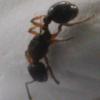2. Date of collection: 4/23/15
3. Habitat of collection: Sandy/wooded
4. Length (from head to gaster):9-10mm
5. Color, hue, pattern and texture: Red head and body black gaster.
6. Distinguishing characteristics:
7. Anything else distinctive:
8. Nest description:



















